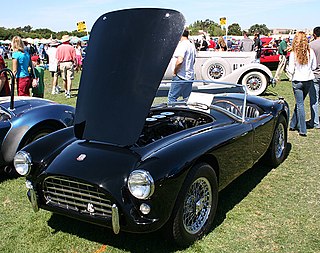This article relies largely or entirely on a single source .(March 2019) |
In 1960 Heron Plastics of Greenwich, London was well established as a manufacturer of GRP bodyshells for Austin 7 specials. One of these was used as the basis for the original Diva GT in 1961. By this time, Heron also built their own coupe, the Europa, although they did not debut it until the 1962 Racing Car Show.

Greenwich is an area of southeast London, England, located 5.5 miles (8.9 km) east-southeast of Charing Cross. It is located within the Royal Borough of Greenwich, to which it lends its name.

The Austin 7 is an economy car that was produced from 1922 until 1939 in the United Kingdom by Austin. It was nicknamed the "Baby Austin" and was at that time one of the most popular cars produced for the British market and sold well abroad. Its effect on the British market was similar to that of the Model T Ford in the US, replacing most other British economy cars and cyclecars of the early 1920s. It was also licensed and copied by companies all over the world. The very first BMW car, the BMW Dixi, was a licensed Austin 7, as were the original American Austins. In France they were made and sold as Rosengarts. In Japan, Nissan also used the 7 design as the basis for their first cars, although not under licence. This eventually led to a 1952 agreement for Nissan to build and sell Austins in Japan under the Austin name.
Diva was a British manufacturer of sports cars from 1961 to 1966. It was a subsidiary of the Tunex Conversions Co set up by Don Sim in Camberwell, London, but in 1966 Diva Cars Limited became its registered name. In 1967, after car production ceased, the name changed again to Skodek Engineering.
The car had a steel backbone chassis with outriggers fore and aft to support the running gear. Wishbones and coil spring independent suspension provided good handling, it was claimed. The front brakes were discs while drums served at the rear. The GRP body was bonded to this chassis and plywood floorpan. The engine was a Ford straight-four OHV unit with a choice of 997 cc or 1500 cc capacity. With the larger engine, a 0 to 60 mph (97 km/h) time of 8.5 seconds was boasted with a top speed of 115 mph (185 km/h).

A chassis is the framework of an artificial object, which supports the object in its construction and use. An example of a chassis is a vehicle frame, the underpart of a motor vehicle, on which the body is mounted; if the running gear such as wheels and transmission, and sometimes even the driver's seat, are included, then the assembly is described as a rolling chassis.
The Europa was sold in fully trimmed component form at £580 or in partly constructed form at £730.

A kit car is an automobile that is available as a set of parts that a manufacturer sells and the buyer then assembles into a functioning car. Usually, many of the major mechanical systems such as the engine and transmission are sourced from donor vehicles or purchased new from other vendors. Kits vary in completeness, consisting of as little as a book of plans, or as much as a complete set with all components to assemble into a fully operational vehicle such as those from Caterham.
Only 12 examples were produced before the Europa was shelved for financial reasons in 1964.
Peter Monteverdi's MBM Tourismo was based on the Europa.

Peter Monteverdi was a Swiss carmaker and creator of the car brand Monteverdi.

The MBM Tourismo was a very low-production automobile sold by Peter Monteverdi. Monteverdi's small company MBM mainly focused on competition, but a "few" sports cars were also produced.

















